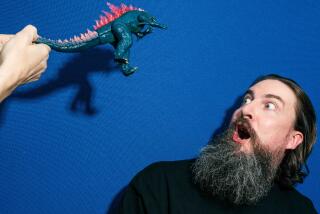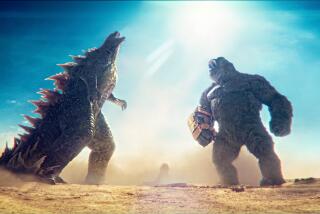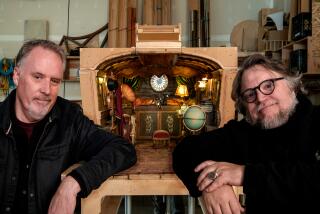Here’s what went into the making of the creature from ‘Shape of Water’
Over the course of six films directed by Guillermo del Toro, Doug Jones has played, among other creations, a duplicitous faun, a fearsome child-eating ogre known as the Pale Man and the blood-red ghosts that haunt the falling-to-ruin estate in 2014’s “Crimson Peak.” But the filmmaker’s 1960s-set aquatic fairy tale “The Shape of Water” afforded the actor the opportunity to play an entirely new animal — a romantic leading man who finds a heartfelt connection with Sally Hawkins’ mute cleaning lady, Elisa.
Despite the love story at the heart of the film, for Jones, the process of bringing the creature to life remained the same as previous roles.
“My challenge is to make that character look like he woke up that way that day, not like he’s a guy in a suit,” he said. But for the film’s creative team, designing and building the elaborate creature suit and makeup that Jones wears on screen was a laborious, painstaking endeavor. Del Toro himself financed three years of development and design on the creature, which took dozens of artisans and craftsmen to conjure using foam, silicone and state-of-the-art digital technology.
WATCH: Video Q&A’s from this season’s hottest contenders »
Well before the film, which opened last week, had a green light from Fox Searchlight, the filmmaker had recruited artists David Grasso and David Meng to sculpt in clay a rough form of the creature. To refine his facial features, Del Toro turned to sculptor and creature designer Mike Hill, whose previous film credits include 2010’s “The Wolfman” and 2006’s “Apocalypto” and who has done personal work for the writer-director in the past, including building lifelike sculptures for his suburban Los Angeles retreat known as Bleak House.
Hill did pencil sketches of the face of the creature (whom the filmmakers eventually nicknamed “Charlie” for the former Star-Kist mascot Charlie the Tuna) trying to find the perfect combination of animalistic and human traits. “I realized that this thing had to be attractive because it has a relationship with Sally’s character,” Hill said. He gave the Amphibian Man “voluptuous male-model-type lips … a strong jaw, a cleft chin, all the things that make a man handsome, which is a fine line because you also have to get back to that no-nose and huge eyes that a fish has.”
Working from Hill’s designs, the artists at Legacy Effects created facial appliances from silicone that could be applied directly to Doug’s skin. The creature’s body, however, was a foam-rubber suit that stretched from Jones’ feet up to his neck and down to his wrists (the hands were added separately so they could be removed more easily to give Jones the use of his own hands as needed during filming). Del Toro, who began his career as a special makeup effects artist, felt strongly that silicone should be used sparingly because of the way it can read on screen once it has been painted.
“He had a fear of it being slimy,” says Legacy Effects supervisor and co-creature designer Shane Mahan, who previously worked with Del Toro on 2013’s “Pacific Rim.” “What we did, though, [was] we had hybrid areas that were silicone… areas like the fins, the gills, the webs of the fingers just to catch backlight, so that in the audience’s mind at least, it telegraphs as familiar, like the webbing of a frog’s foot or a fish’s gill. There’s light you see through that.”
Both the facial appliances and the body were designed to cleave as closely as possible to Jones’ head and impossibly lean frame to keep the suit from sagging and the head from seeming too bulbous; the application process took roughly three hours. “The suit itself from the neck down had to be skin-tight so there wouldn’t be funny wrinkles when you’d bend an arm or a knee,” Jones said. “It was so incredibly skin-tight that it took three people to help me get it on — it was a shimmy act. If it was set to music, it would have been the perfect dance number.”
For the creature’s gills, Mahan devised a mechanism that could be discreetly tucked into the back of the suit and could be operated remotely on set. For the eyes, Jones wore specially crafted lenses created out of acrylic resin by the artist known as Kazu, which snapped magnetically into a housing on his face shaped not unlike a bandit’s mask. The design gave the makeup artists the ability to easily remove or switch out the lenses as needed during filming.
“For extreme close-ups, I had eyes that I couldn’t see anything out of,” Jones said. “I had to know the geography of the room pretty well before we put those eyes in. We had other versions of the eyes I could see a little bit more through — the pupils had been cut out for wide shots where I’d have to move across a room or swim around underwater.”
Eye blinks, along with other “micro-expressions” such as the furrowing of the brow, were added digitally in post-production. Each shot, however, was based on scans of Jones’ own expressions. All were completed under Del Toro’s specific supervision. “We’d do a take of animation and he’d say, ‘No, no. That’s too much. The brows need to come down,’” said visual effects supervisor Dennis Berardi of Toronto’s Mr. X. “He would act it out for us. He would take his glasses off and say, ‘This is what I want,’ and he would literally do the facial expression.”
The team at Mr. X also carefully enhanced one of the creature’s most unique qualities — his subdermal bioluminescence. Mahan initially came up with the idea of including the effect as part of the creature’s anatomy, drawing inspiration from deep-sea creatures. The suits Legacy built for the production (four primary creature suits were constructed) were highlighted with an invisible ultraviolet paint that when illuminated by a specific kind of light on set would burn bright blue.
But the digital flourishes were always intended to be subtle — the goal was simply to amplify the emotion inherent in Jones’ original performance, delivered as it was under difficult physical conditions, and to underscore the magical qualities of the creature at the heart of Del Toro’s romantic fable. “Doug has a lot of experience emoting through special-effects makeup,” Berardi said. “Our approach really was to try to retain as much of Doug as we could and replace only what we had to replace.”
See the most read stories this hour »
More to Read
From the Oscars to the Emmys.
Get the Envelope newsletter for exclusive awards season coverage, behind-the-scenes stories from the Envelope podcast and columnist Glenn Whipp’s must-read analysis.
You may occasionally receive promotional content from the Los Angeles Times.







